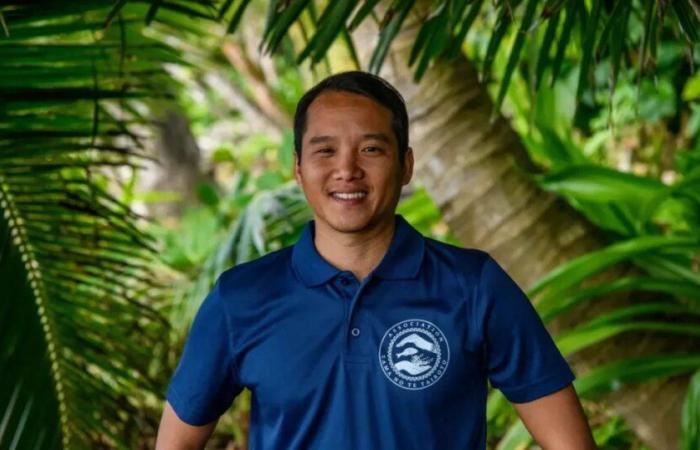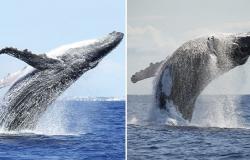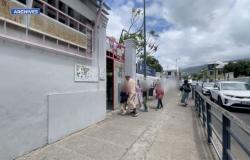The theory of Evolution is decidedly incomplete. We can be born Homo sapiens in the Ocean and never really come out. Like waterwoman Puatea Ellis, Vetea Liao, a 39-year-old marine biologist, has built her life in Polynesian waters. Where his compatriot excels in swimming and sliding disciplines, Vetea turned to science, wanting to know the workings of aquatic ecosystems in every detail.
A passion that blossomed very early with his fisherman father, who paved the way for him towards biology. With it, he dives, learns to know the species, their behavior depending on the environment, their interweaving in a fragile balance. The first experiences fueled a bulimia bulimia for the young man: the need to remain in direct contact with nature, like a symbiote.
Unsurprisingly, after high school, Vetea headed to study marine biology in Cherbourg, before specializing in Australia, where he discovered the Great Barrier Reef. A significant encounter: it was from this moment that he grasped the set of complex interactions between aquatic fauna and flora, which he compared to a “ constellation “. He begins to analyze the behavior of species and their dynamics, and above all to ask the question of his own impact on marine ecosystems.
Back in Polynesia, Vetea begins to write down everything he observes in a notebook. “ My outlook had changed thanks to my studies. I started to note phenomena that I saw underwater, aggregations of fish spawning which were super interesting, on which we had no information. “, he explains. Notes that he compiles online, and that he regularly adds to with his experiences to become more experienced: an inventory of Moorea species for the Gump Station, the installation of an aquaculture farm in Tautira, or studies on the Arctic terrain, Canada. It was on his return from the far North, in November 2014, that he came across a strange cloud in the lagoon of Moorea one morning. A spawning of corals, in reality, which will shake up its prospects.
A coral named Porites Rus
Coral spawning usually takes place at night. Almost no studies exist on those that breed during the day. His colleagues at Criobe have never observed this phenomenon. “It will be 4 years before I can have any new information. A friend who sees it in 2018. It gave me a hypothesis on when it happens “, he says. His intuition was correct: a year later, he validated it thanks to several friends who observed the laying of this species, named Porites Rus, at the expected time.
On a mission to Wallis, he learned about it… by email. “ I see that yes, we had predicted at 7 a.m., there was one who got it at 7:07 a.m., the other at 6:59 a.m., the other at 7:12 a.m. and they were scattered over four sites around Tahiti and in Moorea. And that’s super exciting. We already have the first images because they all took photos. And we had a very precise time “, he remembers.
He will only see it with his own eyes in 2020. The rumor is spreading “ by word of mouth “, so much so that its increasingly vast network of informal observers led Vetea to draw this conclusion: the species lays eggs once a month, from November to April, on several islands at the same time, five days after the full moon. “ We realized that the phenomenon is simultaneous in several places, that it is always predictable almost to the minute. To go further, to really set up a larger network, we decided to create our structure », he continues.
In 2021, he founded Tama No Te Tairoto, with Anne-Marie Trinh and Marguerite Taiarui. More than observing corals, the association aims to improve and share knowledge about the lagoon. And there is no shortage of work: Vetea chooses to make her job available at the marine resources department, in January 2024, to focus on the association.
Happy timing, since Jerry Biret, today Mr. JT Vert on TNTV, did not take long to inspire him with an idea “ internationale ». « He hosts another event (Earth Hour) where everyone must turn off their lights at the same time, on the same day, at the same time. And he told me: we can do the same thing with coral spawning. We can try to mobilize people in all countries on the same day and get everyone in the water “. Because since the first observations of Vetea, the laying of Porites Rus has been observed in Fiji, Reunion, Seychelles and Indonesia. Tama No Te Tairoto then lays the first stone of his project Connected by the reeflast August.
Read also: A Polynesian association launches a global observation project for “Porites rus” coral spawning
The objective is simple: to bring together observers from around fifty countries around the world, from the South Pacific to the Red Sea via the Indian Ocean, for an observation of synchronized spawning of Porites Rus, which could well be one of of the most important in the animal kingdom. About an hour and a half after sunrise, on January 18 or 19, 2025 depending on the region of the world, 90% of these corals should spawn in the lagoon and then in the Ocean. The event will be coordinated from Tahiti.
A new exciting adventure for Vetea, which must use all its communication know-how. “ You have to be able to reach people in lots of countries who don't know your association, who don't know the species you're talking about, whether they are scientists, diving clubs, members of associations or just ordinary citizens. », he notes, emphasizing the training and information phase essential to the success of the project. To successfully collect data, each volunteer observer will enter their notes into a dedicated application.
It is clear that Connected by the reef has media success, while waiting for the scientific component, since it was awarded a grand prize at the To'a Reef trophies on October 25. The United Nations has also recognized it as “event of the decade for ocean science “. The ceremony will take place on November 13.
Read also: Launched from Polynesia, the global observation of coral spawning labeled “Event of the United Nations Decade”
« I have faith in my predictions in the Southern Hemisphere. Where we don't know, and that's the goal of the project, that's all that's going to happen in the northern hemisphere (…) logically, egg-laying should take place there in July or June. But we have a big uncertainty in the areas which are close to the equator. Whether you are at 5 degrees south or 5 degrees north, the environmental conditions are not very different », Vetea smiled.
A project “ game changer » ?
The project thus aims to support the thesis of the natural reconstruction of reefs, at the same time as curbing harmful human activities, or simply counterproductive according to him. “ We must be well aware that we will never save an entire coral reef through human action. We can have money, but the only way to regenerate these reefs on a very large scale is this type of phenomenon. », insists Vetea. Especially since the laying days of Porites Rus can be predicted over 10 to 20 years.
The fact remains that the growing competition to obtain exploration licenses – before probable exploitation – of the largely unknown seabed, and the economic pressure on the various EEZs hardly encourage optimism. “ We have no idea how this deep ecosystem is linked to tuna resources or other resources that we exploit, primary resources (…) we must realize that the ocean is an entity. Our reefs are dependent on each other, from Polynesia to the Cook Islands for example. If the Cook Islands start exploiting a resource in their EEZ, we have no idea how it will impact Polynesian tuna stocks. » Pointe Vetea.
The biologist is not naive about industrial predation on marine resources or the anchoring of consumption habits in Polynesia. “ The need for these materials, these resources, is there now. The question I often ask myself is what will one day allow us to completely change? », he asks. “ Sometimes you can get electroshocks, but they don't last long enough ».
Read also: Ifrecor Polynesia unveils the winners of the 1st edition of the TO'A Reef Trophies
Vetea hopes to be able to continue the associative adventure as long as possible. Paid for the project, it is currently limited to the work of numerous volunteers, on whom it depends. He hopes to be able to recruit a second full-time person with him to bring his other projects to fruition, such as coral restoration without equipment, using locals steeped in empirical knowledge. “ I believe in this approach. Because again, paying people or relying on volunteers to do things is completely different from when people are busy in front of their homes. It's personal and they want it to look good “, he emphasizes.
Other projects of the association, a guide to the corals of Polynesia, which does not yet exist, support for rahui and fisheries management committees for ecological monitoring of their area, or the creation of marine educational areas. “ We could also develop things on riversadds the biologist. We really don't talk about it much even though there is a small biodiversity with many endemic species that we don't take much care of. ».
Vetea Liao will be this Wednesday, November 20 in Bordeaux, on the occasion of the Sea Economy Conference.
Joseph Poullain for TNTV






